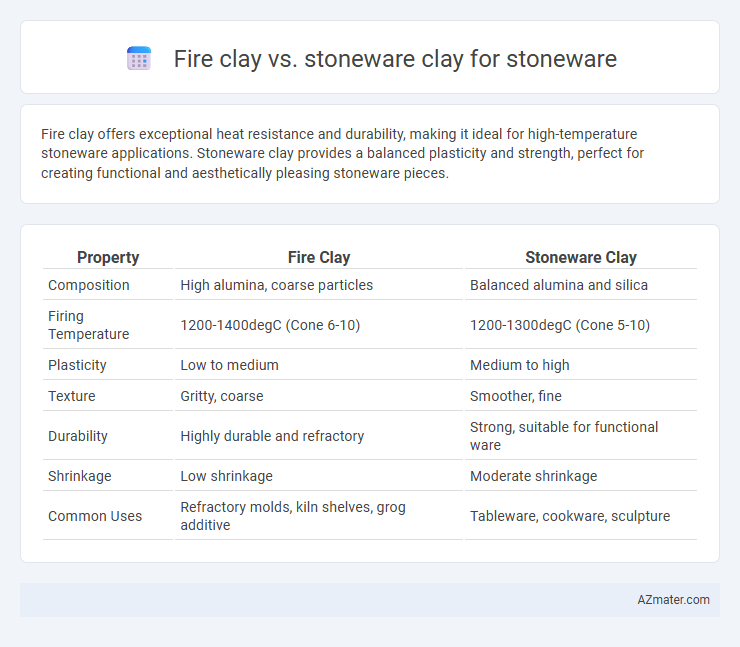Fire clay offers exceptional heat resistance and durability, making it ideal for high-temperature stoneware applications. Stoneware clay provides a balanced plasticity and strength, perfect for creating functional and aesthetically pleasing stoneware pieces.
Table of Comparison
| Property | Fire Clay | Stoneware Clay |
|---|---|---|
| Composition | High alumina, coarse particles | Balanced alumina and silica |
| Firing Temperature | 1200-1400degC (Cone 6-10) | 1200-1300degC (Cone 5-10) |
| Plasticity | Low to medium | Medium to high |
| Texture | Gritty, coarse | Smoother, fine |
| Durability | Highly durable and refractory | Strong, suitable for functional ware |
| Shrinkage | Low shrinkage | Moderate shrinkage |
| Common Uses | Refractory molds, kiln shelves, grog additive | Tableware, cookware, sculpture |
Introduction to Fire Clay and Stoneware Clay
Fire clay, characterized by its high refractory properties and rich alumina content, is ideal for withstanding extreme temperatures in kiln linings and fire bricks. Stoneware clay contains a balanced mix of kaolin, ball clay, and feldspar, offering plasticity and durability suited for functional pottery and dinnerware fired at mid to high temperatures (1200degC-1300degC). While fire clay enhances heat resistance and thermal shock resistance, stoneware clay provides strength and vitrification necessary for robust stoneware ceramics.
Composition Differences Between Fire Clay and Stoneware Clay
Fire clay contains a higher proportion of alumina and silica, providing increased refractory properties and resistance to high temperatures compared to stoneware clay. Stoneware clay typically includes more fluxing agents like feldspar, which lower its melting point and contribute to its vitrification and durability after firing. The distinct mineral compositions result in fire clay being ideal for kiln bricks and fireproof bricks, while stoneware clay is better suited for functional pottery and tableware.
Firing Temperatures: Fire Clay vs Stoneware Clay
Fire clay typically withstands higher firing temperatures, ranging from 2200degF to 2500degF (1204degC to 1371degC), making it ideal for refractory applications and high-temperature stoneware. Stoneware clay generally matures at lower temperatures, around 2150degF to 2300degF (1177degC to 1260degC), resulting in durable, vitrified pottery with good strength and durability. Understanding these firing temperature differences ensures optimal performance and prevents defects like warping or bloating in the finished stoneware products.
Workability and Plasticity: Which Clay is Easier to Shape?
Fire clay contains higher grog content, providing excellent thermal resistance but making it less plastic and more challenging to shape. Stoneware clay boasts superior plasticity and workability, allowing for easier molding and smoother shaping during pottery creation. For stoneware ceramics, stoneware clay is typically preferred due to its balance of durability and ease of manipulation.
Shrinkage Rates: What to Expect from Each Clay
Fire clay typically exhibits lower shrinkage rates, around 6-8%, making it ideal for sculptural and thick-walled stoneware pieces that require dimensional stability during firing. Stoneware clay generally shrinks more, ranging from 10-14%, which can lead to slight warping or deformation if not carefully managed. Understanding these shrinkage differences is crucial for potters aiming to control final form precision and prevent cracking or distortion in stoneware ceramics.
Color and Texture Variations
Fire clay exhibits a dense, coarse texture with a rich reddish-brown or buff color, creating a rustic finish ideal for robust stoneware pieces. Stoneware clay tends to have a finer, smoother texture and ranges in color from light gray to tan, allowing for versatility in glazing and surface treatments. Variations in mineral content between fire clay and stoneware clay directly influence firing temperatures, resulting in distinct color depth and tactile qualities.
Durability and Finished Strength
Fire clay exhibits high durability and withstands elevated temperatures without warping, making it ideal for stoneware that requires robust heat resistance. Stoneware clay, known for its vitrification properties, achieves enhanced finished strength after firing due to its dense, non-porous structure. Both clays contribute to durable stoneware, but fire clay excels in heat tolerance while stoneware clay offers superior mechanical strength in the final product.
Glazing Compatibility and Surface Effects
Fire clay offers excellent durability and thermal resistance, making it highly compatible with high-temperature stoneware glazes that require strong adhesion and minimal crazing. Stoneware clay provides a smoother surface texture, allowing glazes to develop richer, more vibrant finishes with enhanced color depth and variation. The differing particle sizes in fire clay contribute to a slightly more textured surface after firing, which can affect glaze pooling and result in unique surface effects.
Best Uses: When to Choose Fire Clay or Stoneware Clay
Fire clay is ideal for high-temperature applications such as kiln shelves, fireplaces, and industrial refractory products due to its exceptional heat resistance and durability. Stoneware clay is best suited for functional pottery and dinnerware because of its ability to vitrify at mid-range to high firing temperatures, resulting in a dense, non-porous finish. Choose fire clay for thermal stress resistance and structural components; opt for stoneware clay when creating durable, glazed ceramics for everyday use.
Conclusion: Selecting the Right Clay for Your Stoneware Projects
Fire clay offers exceptional heat resistance and durability, making it ideal for high-temperature stoneware projects requiring thermal shock resistance. Stoneware clay provides versatility with a balance of plasticity and strength, suitable for functional pottery and artistic creations. Choosing between fire clay and stoneware clay depends on the specific project requirements, such as firing temperature, durability needs, and desired texture.

Infographic: Fire clay vs Stoneware clay for Stoneware
 azmater.com
azmater.com